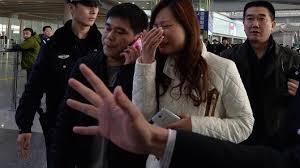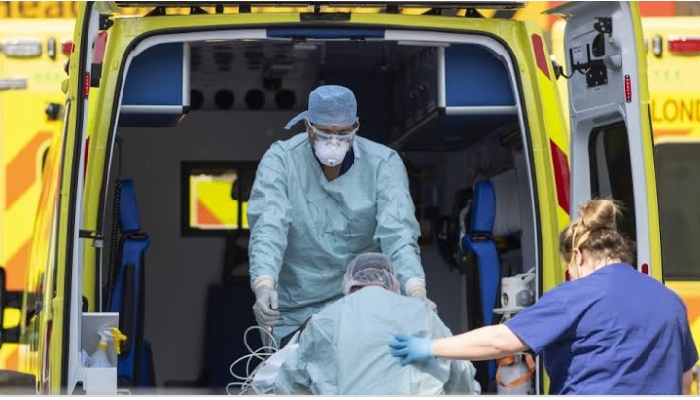Kuala Lumpur, Mar 8: Vietnamese air force planes on Saturday spotted two large oil slicks in the area where a Malaysia Airlines Boeing 777 vanished earlier in the day, the first sign that the aircraft carrying 239 people on board had crashed.
The air force planes were part of a multinational search operation launched after Flight MH370 fell off radar screens less than an hour after it took off from Kuala Lumpur for Beijing early Saturday morning.
A Vietnamese government statement said the slicks were spotted late Saturday off the southern tip of Vietnam and were each between 10 kilometers (6 miles) and 15 kilometers (9 miles) long. There was no confirmation that the slicks were related to the missing plane, but the statement said they were consistent with the kinds that would be produced by the two fuel tanks of a crashed jetliner.
Two-thirds of the missing plane's passengers were from China, while others were from elsewhere in Asia, North America and Europe.
Malaysia Airlines CEO Ahmad Jauhari Yahya said there was no indication that the pilots had sent a distress signal, suggesting that whatever happened to the plane occurred quickly and possibly catastrophically.
At Beijing's airport, authorities posted a notice asking relatives and friends of passengers to gather at a nearby hotel to wait for further information, and provided a shuttle bus service. A woman wept aboard the bus while saying on a mobile phone, "They want us to go to the hotel. It cannot be good."
Relatives and friends of passengers were escorted into a private area at the Lido Hotel, and reporters were kept away. A man in a gray hooded sweatshirt later stormed out complaining about a lack of information. The man, who said he was a Beijing resident but declined to give his name, said he was anxious because his mother was on board the flight with a group of 10 tourists.
"We have been waiting for hours and there is still no verification," he said.
The plane was last detected on radar at 1:30 a.m. (1730 GMT Friday) around where the South China Sea meets the Gulf of Thailand, authorities in Malaysia and Vietnam said.
Lai Xuan Thanh, director of Vietnam's civil aviation authority, said air traffic officials in the country never made contact with the plane.
The plane "lost all contact and radar signal one minute before it entered Vietnam's air traffic control," Lt. Gen. Vo Van Tuan, deputy chief of staff of the Vietnamese army, said in a statement.
The South China Sea is a tense region with competing territorial claims that have led to several low-level conflicts, particularly between China and the Philippines. That antipathy briefly faded as China, the Philippines, Vietnam, Singapore and Malaysia all sent ships and planes to the region.
Malaysian Prime Minister Najib Razak said that Malaysia had dispatched 15 planes and nine ships to the area, and that the US navy was sending some planes as well. Singapore, China and Vietnam also were sending aircraft.
It's not uncommon for it to take several days to find the wreckage of aircraft floating on the ocean. Locating and then recovering the flight data recorders, vital to any investigation, can take months or even years.
"In times of emergencies like this, we have to show unity of efforts that transcends boundaries and issues," said Lt. Gen. Roy Deveraturda, commander of the Philippine military's Western Command.
Thanh said Malaysian, Singaporean and Vietnamese search officials were coordinating operations in an 11,200-square-kilometer (4,324-square-mile) area where the plane was last known to be. He said Vietnamese fishermen in the area were asked to report any suspected sign of the missing plane.
The air search was suspended for the night and was to resume Sunday morning, while the sea search was ongoing, the airline said.
The plane was carrying 227 passengers, including two infants, and 12 crew members, the airline said. It said there were 152 passengers from China, 38 from Malaysia, seven from Indonesia, six from Australia, five from India, three from the U.S., and others from Indonesia, France, New Zealand, Canada, Ukraine, Russia, Italy, Taiwan, the Netherlands and Austria.
In Kuala Lumpur, family members gathered at the airport, but were kept away from reporters.
"Our team is currently calling the next of kin of passengers and crew. Focus of the airline is to work with the emergency responders and authorities and mobilize its full support," said Yahya, the airline CEO. "Our thoughts and prayers are with all affected passengers and crew and their family members."
Fuad Sharuji, Malaysia Airlines' vice president of operations control, told CNN that the plane was flying at an altitude of 35,000 feet (10,670 meters) and that the pilots had reported no problem with the aircraft.
Asked whether terrorism was suspected, Malaysian transport minister Hishammuddin Hussein said authorities had "no information, but we are looking at all possibilities."
Malaysia Airlines has a good safety record, as does the 777, which had not had a fatal crash in its 19-year history until an Asiana Airlines plane crashed in San Francisco in July 2013, killing three passengers, all teenagers from China.
Airliner "black boxes" — the flight data and cockpit voice recorders — are equipped with "pingers" that emit ultrasonic signals that can be detected underwater. Under good conditions, the signals can be detected from several hundred miles away, said John Goglia, a former member of the U.S. National Transportation Safety Board. If the boxes are trapped inside the wreckage, the sound may not travel as far, he said.
Air France Flight 447, with 228 people on board, disappeared over the Atlantic Ocean en route from Rio de Janeiro to Paris on June 1, 2009. Some wreckage and bodies were recovered over the next two weeks, but it took nearly two years for the main wreckage of the Airbus 330 and its black boxes to be located and recovered.
Malaysia Airlines said the 53-year-old pilot of Flight MH370, Zaharie Ahmad Shah, has more than 18,000 flying hours and has been flying for the airline since 1981. The first officer, 27-year-old Fariq Hamid, has about 2,800 hours of experience and has flown for the airline since 2007.
The tip of the wing of the same Malaysian Airlines Boeing 777-200 broke off Aug. 9, 2012, as it was taxiing at Pudong International Airport outside Shanghai. The wingtip collided with the tail of a China Eastern Airlines A340 plane. No one was injured.
Malaysia Airlines' last fatal incident was in 1995, when one its planes crashed near the Malaysian city of Tawau, killing 34 people. The deadliest crash in its history occurred in 1977, when a domestic Malaysian flight crashed after being hijacked, killing 100 people.
In August 2005, a Malaysian Airlines 777 flying from Perth, Australia, to Kuala Lumpur suddenly shot up 900 meters (3,000 feet) before the pilot disengaged the autopilot and landed safely. The plane's software had incorrectly measured speed and acceleration, and the software was quickly updated on planes around the world.
Malaysia Airlines has 15 Boeing 777-200s in its fleet of about 100 planes. The state-owned carrier last month reported its fourth straight quarterly loss and warned of tougher times.






Comments
Add new comment